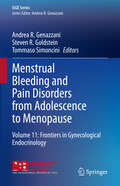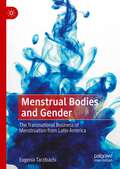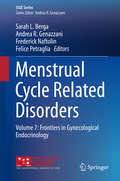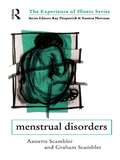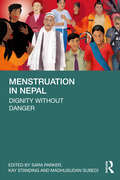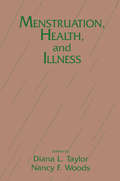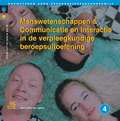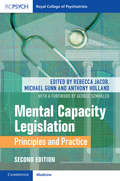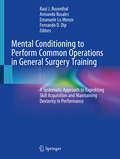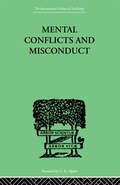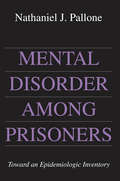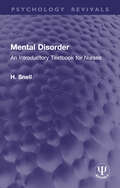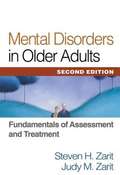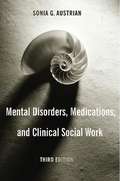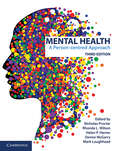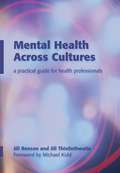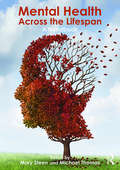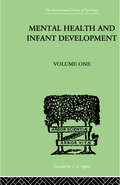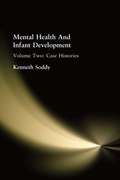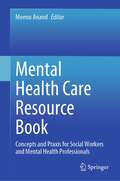- Table View
- List View
Mensch! Erstaunliches über den Körper
by Martina Kahl-ScholzDieses Buch klärt interessierte Laien über erstaunliche Fakten und Prozesse bei Medizin und Gesundheit auf. Warum würden wir ohne Schlaf sterben? Wie kommt es zum Jojo-Effekt? Wieso haben alle unsere Körperzellen im Grunde ihre eigene Nase? Warum altern wir und lässt sich das wirklich aufhalten? Wie entwickelt sich das Denken? Und warum kann ein Placebo bei der Heilung so effektiv sein wie eine Operation? Diesen und weiteren Fragen rund um verschiedene Vorgänge im menschlichen Körper geht die Autorin nach. Erfahren Sie von faszinierenden medizinischen Zusammenhängen – und warum wir doch natürliche Feinde haben, Schmerz empfinden, was uns aus dem Gleichgewicht bringt und unsere Stimme anders klingen lässt. Und wussten Sie eigentlich schon, was genau Intuition ist? Tauchen Sie ein in die Vielfalt Mensch und lassen Sie sich von Ihrem eigenen Körper verblüffen.
Menschenführung und Leadership in der Pflege (Top im Gesundheitsjob)
by Joel SmolibowskiDer Schlüssel zum professionellen Umgang mit Menschen! Die Fähigkeit, professionell mit Menschen umzugehen, ist essenziell für die Beschäftigten der Gesundheitsfachberufe. Der erfahrene Autor vermittelt hierzu auf einfache und sofort umsetzbare Weise das notwendige Basiswissen. Ob als Schichtleitung, mit Angehörigen oder im interprofessionellen Team - lernen Sie die Grundlagen und Methoden, um richtig zu agieren und sich gut auszudrücken. Die drei wichtigen Kompetenzen Authentizität, Verantwortungsbewusstsein und die Fähigkeit, klar zu kommunizieren, können erlernt und trainiert werden. Denn Menschenführung bedeutet mehr, als nur zu sagen wo „es langgehen soll“. „Leadership“ bedeutet das Vorleben von Werten und Verantwortung zum Wohl eines guten und gesunden Miteinander.
Menschliches Leid - Perspektiven der Philosophie und Theologie, des Buddhismus und der Medizin: Medizinische Gesellschaft Mainz e.V.
by Theodor Junginger Monika Seibert-Grafe Mechthild Dreyer Tonke DennebaumIn diesem Buch werden die Sichtweisen der Philosophie, der christlichen und jüdischen Theologie, des Buddhismus, der Medizin sowie der Psychologie und Psychotherapie auf das Leid der Menschen dargestellt. Das eigene und das fremde Leid gehören grundlegend zum Leben der Menschen dazu, ebenso wie Freude und Glück. Den körperlichen oder seelischen Belastungen können viele Ursachen zugrunde liegen und oft werden Fragen nach dem Warum oder dem Sinn gestellt. Betroffene hadern damit, dass ausgerechnet sie die Erfahrung von Leid machen müssen. Diese Fragen nach den Ursachen, der Erklärung und der Bedeutung von Leid sowie die Möglichkeiten der Linderung und der Bewältigung von Leid diskutieren die Autoren im Kontext ihrer jeweiligen Fachgebiete, so dass sich dem Leser eine breite, und interdisziplinäre Sicht auf das menschliche Leid eröffnet.Weiterhin wird die Perspektive eines unmittelbar von Leid Betroffenen durch seine einprägsame Schilderung des Erlebten vermittelt.
Menstrual Bleeding and Pain Disorders from Adolescence to Menopause: Volume 11: Frontiers in Gynecological Endocrinology (ISGE Series)
by Andrea R. Genazzani Tommaso Simoncini Steven R. GoldsteinThis book focuses on menstrual cycle bleeding and pain disorders from menarche to menopause. Hormonal and tissue basis of menstrual cycle are described as well as the role of ultrasound in the evaluation of normal and abnormal endometrium and sex steroid hormones used in the treatment of such disorders. How to identify patients with coagulation disorders, the correlation of AUB in early menarche and PCOS later in adolescence and adolescent menorrhagia are extensively analysed for their clinical and therapeutic implication.Anovulatory syndromes and luteal phase defects are explained for their pathogenesis and role in women health. Dysmenorrhea and other pain syndromes as well PMS and PMDD are analysed for their diagnosis and management and the impact of endometriosis, adenomyosis and uterine myoma for the linkage of these organic diseases, inflammation and bleeding and pain disorders related to menstrual cyclicity. Endometrial hyperplasia and malignancy are also extensively examined for their pathogenesis, symptoms and role in uterine bleeding and pelvic pain as well as how to face oncological therapies induced amenorrhea. The last part of the book analyses and discuss the causes of menorrhagia in menopausal transition and the management of bleeding disorders under menopause hormone therapy.Written by experts in the field, this book will be of benefits to residents, general practitioners and specialists, gynaecologists, endocrinologists, paediatricians and GPs who deal with women’s health care.
Menstrual Bodies and Gender: The Transnational Business of Menstruation from Latin America
by Eugenia TarzibachiThis book interrogates how the so-called “Feminine Care” industry travelled from the United States to Latin America via manufactured and disposable menstrual management technologies and certain narratives about menstrual bodies. The author focuses on Argentina as a case study to deepen the analysis of transnational politics and business practices around menstruation, drawing on women’s voices to unveil why menstruation is still a bodily process that is natural yet taboo in Latin America. This fascinating volume is a must-read for anyone interested in how the “Feminine Care” industry helped reify the insidious social mandate of shame and secrecy over women’s bodily experiences.
Menstrual Cycle Related Disorders: Volume 7: Frontiers in Gynecological Endocrinology (ISGE Series)
by Andrea R. Genazzani Sarah L. Berga Frederick Naftolin Felice PetragliaThis volume discusses menstrual cycle related disorders, which are a major concern from adolescence to menopause. Starting from hypothalamic pituitary gonadal axis regulation, it analyzes the characteristics and treatments of hypothalamic amenorrhea and eating disorders, as well as polycystic ovary and adolescent hyperandrogenism. It also examines the importance of body composition and physical performance. The book particularly focuses on the diagnosis of and therapies for hormone-related headaches, the management of trans sexuality in the gynecological outpatient area, dysfunctional uterine bleeding and premature ovarian insufficiency. Further, it analyzes the basic, clinical and therapeutic aspects of endometriosis, as well as the important opportunities that SPRMs (selective progesterone receptor modulators) offer in contraception and fibroid therapy. This book is a useful tool for gynecologists, endocrinologists and general practitioners, and is a valuable resource for all physicians involved in women’s health.
Menstrual Disorders
by Graham ScamblerWhat does modern medical science know about menstruation? Less than is commonly assumed, according to Annette and Graham Scambler. In this thought-provoking book, they challenge orthodox thinking on menstruation and disorders associated with it. Based on women's own experience and accounts of menstruation and menstrual disorders, their study will prompt health workers to rethink their approaches to menstrual phenomena. It shows how women are conditioned to regard menstruation as problematic, highlights the disadvantages as well as the advantages of progressive medicalization of menstrual phenomena, and discuss how menstruation is perceived within male culture.
Menstruation in Nepal: Dignity Without Danger
by Madhusudan Subedi Kay Standing Sara ParkerThis book examines the complexities of menstrual beliefs and practices in Nepal. Taking an interdisciplinary and intersectional approach, it explores and promotes the rights of women, girls, and people who menstruate to a dignified and healthy menstruation.The volume• collates current research in Nepal from local academics, early career researchers, and the Dignity Without Danger research project;• provides a more nuanced understanding of the complex stigmas and taboos that surround menstruation;• highlights the importance of rethinking ideas of religion, gender, menstruation, stigma and taboos, cultural practises, and discrimination;• proposes a counter-narrative that places sociological studies at the heart of the discussion surrounding menstruation; and• calls for more collaborative action research to strengthen the links between academia and activism across disciplines.An authoritative contribution, the book will be of interest to scholars and researchers of gender studies, public health, sociology, human rights, South Asian studies, medical sociology, cultural studies, and social medicine, particularly for those concerned with Nepal.
Menstruation, Health And Illness (A Health Care for Women International Publication)
by Diana L. Taylor and Nancy F. WoodsThe seventh conference of the Society for Menstrual Cycle Research, held at the University of Michigan in Ann Arbor in June 1987, continued the work of previous meetings to provide a forum for research and knowledge about menstrual cycle phenomena. Founded in 1978, The Society for Menstrual Cycle Research is an organization of scientists, scholars, clinicians, students, and consumers who share an interest in women's lives and health needs as these relate to the menstrual cycle. In addition to the main theme, the seventh conference focused on (a) psychosocial, cultural, and historical aspects of the menstrual cycle, (b) theoretical issues and management considerations for premenstrual syndrome, and (c) future directions in menstrual cycle research.First published in 1991. Routledge is an imprint of Taylor & Francis, an informa company.
Menswetenschappen & communicatie en interactie in de verpleegkundige beroepsuitoefening
by Hilde De Vocht J.H.J. de JongIn dit boek wordt ingegaan op psychologie, sociologie, antropologie, filosofie en agogiek, zodat een compleet boekwerk voor de menswetenschappen ontstaat. Het boek kent drie delen: theorie, toepassing in de beroepsuitoefening, toepassing bij specifieke zorgcategorieen
Mental Capacity Legislation: Principles and Practice
by Rebecca Jacob Michael Gunn Anthony HollandCrucial to health and social care practice, the Mental Capacity Act (MCA) 2005 safeguards decision-making within a legal framework. This book provides theoretical, practical and up-to-date guidance on mental capacity legislation. It focuses on the theory underpinning the principles of the MCA 2005, including historical background, and the practical challenges in applying legal statute in varied clinical settings, from hospitals to social care in community settings. Recent case law is detailed and examples of ethical dilemmas and medico-legal challenges feature, along with guidance to navigate these in clinical practice. Applying mental capacity principles in end-of-life decision-making is an area of discussion, as well as the future of legislative changes in the field. To be read alongside the MCA 2005 Code of Practice, this guide will support mental health and social care professionals in clinical settings.
Mental Conditioning to Perform Common Operations in General Surgery Training: A Systematic Approach to Expediting Skill Acquisition and Maintaining Dexterity in Performance
by Raul J. Rosenthal Fernando D. Dip Armando Rosales Emanuele Lo MenzoThis book is intended for medical students and surgical trainees such as surgical residents and fellows. It provides a practical preparation guide for common surgical procedures. Operations are divided into twelve sections that cover commonly performed general surgery operations such as bariatric, breast, cardiothoracic, colorectal, minimally invasive, and more. The chapters included in these sections aim to assist residents and fellows in facilitating memorization of the operation sequence and movements required to perform a given task. It will also help enhance skill development in the operating room.Written by residents and highly experienced attending surgeons, Mental Conditioning to Perform Common Operations in General Surgery Training: A Systematic Approach to Expediting Skill Acquisition and Maintaining Dexterity in Performance provides a comprehensive systematic approach to performing surgical procedures.
Mental Conflicts And Misconduct
by Healy, WilliamFirst published in 1999. Routledge is an imprint of Taylor & Francis, an informa company.
Mental Disorder Among Prisoners: Toward an Epidemiologic Inventory
by Nathaniel PalloneWhat do we know about the mental health of inmates? What are the implications of what we know? Nathaniel J. Pallone characterizes opinion on these questions as falling into two broad camps: the "tender-hearted," those who see an overlap between mental illness and criminal behavior, and are treatment-oriented; and the "tough-minded," those who have little confidence in psychiatric categories, do not really accept arguments about diminished responsibility, and who feel the emphasis should be on punishment. Which is closer to the truth?When this book was first published, the incidence of mental disorder among prisoners was nearly four times greater than among comparable groups in the general population in part because prisoners are disproportionately drawn from demographic groups with a high incidence of mental disorder—nonwhite and from lower socioeconomic strata. But other data is equally dismaying: mental retardation is 50 percent higher; alcohol and drug abuse is between five and eight times greater; and neurogenic disorders may be 1,700 times greater. In all categories of mental illness, the incidence among prisoners is far higher than among the general population.Pallone asserts that evidence suggests that the design and implementation of mental health care needs serious reevaluation, particularly in view of Supreme Court decisions mandating mental health care despite obstacles with implementation. Palone saw mental health care as the primary issue for those who manage prisons. Sadly, this remains as true as when this book was first published.
Mental Disorder in Canada
by David L. Streiner John CairneyCanada has long been recognized as a leader in the field of psychiatric epidemiology, the study of the factors affecting mental health in populations. However, there has never been a book dedicated to the study of mental disorder at a population level in Canada. This collection of essays by leading scholars in the discipline uses data from the country's first national survey of mental disorder, the Canadian Community Health Survey of 2005, to fill that gap.Mental Disorder in Canada explores the history of psychiatric epidemiology, evaluates methodological issues, and analyzes the prevalence of several significant mental disorders in the population. The collection also includes essays on stigma, mental disorder and the criminal justice system, and mental health among women, children, workers, and other demographic groups. Focusing specifically on Canadian scholarship, yet wide-reaching in scope, Mental Disorder in Canada is an important contribution to the dissemination and advancement of knowledge on psychiatric epidemiology.
Mental Disorder: An Introductory Textbook for Nurses (Psychology Revivals)
by H. SnellOriginally published in 1977, this book was written in response to demands for a textbook of psychiatry which was neither too theoretical, nor so simple that it was inaccurate. It was addressed primarily to pupil nurses in hospitals for the mentally ill, and to student nurses in their first months of training. Its style and content ensured that it could be read with profit by all others whose work brought them into close contact with the mentally ill.The early chapters provide a history of care and treatment, an introduction to psychological development and the unconscious mind, and an explanation of mental disorder and its causes. Specific mental disorders are discussed together with an outline of their treatments, and the general management of the patient is described wherever appropriate. Case illustrations are given as specific examples of various mental conditions. The final chapters cover modern psychological and physical treatments, the aims and means of rehabilitation, and the resources available for the care of the patient in the community. Today it can be read in its historical context.This book is a re-issue originally published in 1977. The language used is a reflection of its era and no offence is meant by the Publishers to any reader by this re-publication.
Mental Disorders in Older Adults, Second Edition
by Steven Zarit Judy ZaritIllustrated with abundant clinical material, this book provides essential knowledge and skills for effective mental health practice with older adults. It demonstrates how to evaluate and treat frequently encountered clinical problems in this population, including dementias, mood and anxiety disorders, and paranoid symptoms. Strategies are presented for implementing psychosocial interventions and integrating them with medications. The book also describes insightful approaches for supporting family caregivers and addresses the nuts and bolts of consulting in institutional settings. Combining their expertise as a researcher and an experienced clinician, the authors offer a unique perspective on the challenges facing older adults and how to help them lead more fulfilling and independent lives. Three reproducible forms can also be downloaded and printed in a convenient 8 1/2" x 11" size.
Mental Disorders, Medications, and Clinical Social Work
by Sonia AustrianWritten for social workers by a social worker, Mental Disorders, Medications, and Clinical Social Work discusses the etiology, epidemiology, assessment, and intervention planning for common mental disorders. Looking at disorders from an ecosystems perspective, Austrian goes beyond a linear classification approach and DSM-IV-TR categories and encourages social workers to analyze the internal and external environmental factors that contribute to a disorder's development. Austrian's discussion of effective intervention(s) for a particular client also stresses the importance of working with families in treating disorders.In addition to information on new medications, biochemical data on the causes of disease, and diagnostic tests, the revised third edition discusses therapies such as motivational interviewing, cognitive-behavioral, interpersonal, and dialectic.
Mental Health
by Nicholas Procter Helen P. Hamer Denise McGarry Rhonda L. Wilson Terry Froggatt Nicholas Procter Helen P. Hamer Denise Mcgarry Rhonda L. WilsonMental ill health represents not only an immense psychological, social and economic burden to society, but also increases the risk and complexity of physical illnesses. Recognising that neuropsychiatric conditions account for 13% of total Disability Adjusted Life Years lost globally, and are estimated to increase to 15% by 2020 (WHO 2004), this book addresses the dynamic nature of professional mental health nursing across the lifespan. Effective mental health care delivery is brought into sharp focus with the release of the Australian Senate Select Committee Report on Mental Health in March 2006. This specially commissioned issue of Contemporary Nurse considers mental health nursing from consumer, nursing practice and community health perspectives. It concludes with recommendations for nurse education, workplace training, and delivery of community care. Violence, 'difficult to treat' disorders, cultural sensitivity, safety of psychotropic medications and application of mental health services in non-mental health settings are addressed from North American, Australian and New Zealand perspectives, which work to build evidence-based research to inform effective mental health practice.
Mental Health 3ed: A Person-centred Approach
by Nicholas Procter Helen P. Hamer Rhonda L. Wilson Denise McGarry Mark LoughheadMental Health: A Person-centred Approach equips students with the tools they need to provide exceptional person-focused care when supporting improved mental health of diverse communities.The third edition has been updated and restructured to provide a more logical and comprehensive guide to mental health practice. It includes new chapters on trauma-informed care, different mental health conditions and diagnoses, suicide and self-harm and the mental health of people with intellectual or developmental disabilities. Significant updates have been made to the chapters on the social and emotional well-being of First Nations Australians and mental health assessment. Taking a narrative approach, the text interweaves personal stories from consumers, carers and workers with lived experience. Each chapter contains 'Translation to Practice' and 'Interprofessional Perspective' boxes, reflection questions and end-of-chapter questions and activities to test students' understanding of key theories. Written by experts in the field, Mental Health remains an essential, person-centred resource for mental health students.
Mental Health Across Cultures: A Practical Guide for Health Professionals
by Jill Thistlethwaite Pascale Moore Jill BensonnEvery health professional interacts with patients from different cultures to their own, not just those from different countries, ethnic or religious groups, but also those with cultural differences due to sexual orientation, lifestyle, beliefs, age, gender, social status or perceived economic worth. The potential for confusions in communication and consequent problems are even greater in primary care mental health than in other areas.This guide for all health professionals provides a model for working in mental health across cultures, and outlines practical ways of using psychotherapy skills across cultures. It can be used as personal preparation by individuals in any primary care setting at home or abroad, or as a teaching tool for use with health professionals travelling to another culture, including overseas aid workers and those moving to a new country. It is also of great value to everyone interested in transcultural medicine. 'Wherever we work, whoever we are, we are working across cultures, often without realising it. The first step is to become conscious of this fact. The next step is to read this book' - Jill Benson and Jill Thistlethwaite.
Mental Health Across the Lifespan: A Handbook
by Michael Thomas Mary SteenMental wellbeing is an integral part of being, and feeling, healthy, and it is estimated that one in four people will suffer from some form of mental illness during their lifetime. In spite of this, it is often overlooked in mainstream healthcare. The overall aim of this book is to provide knowledge and understanding of how mental health affects human beings from conception through to end-of-life, and the challenges that society as a whole has to address in the treatment of mental health. Beginning with an exploration of historical, social and cultural contexts, the book then goes on to discuss mental health care, and mental health promotion, during pregnancy and early parenthood, childhood, adolescence and young adulthood, adulthood for both men and women, and in older people. Containing reflective exercises, the chapters are designed to provide an easily-accessible and engagingly-written introduction to mental health. Containing chapters that can be read and reviewed in isolation, or used as an entire text, Mental Health Across the Lifespan: A Handbook provides a solid introduction to mental health for students. The book will also act as a useful reference for doctors, nurses, midwives, health visitors, allied health professionals, and health and social care support workers who have no specialist mental health training but often work in partnership with, and care for, people suffering from mental health issues.
Mental Health And Infant Development: Volume One: Papers and Discussions
by Kenneth SoddyThis is Volume XXVII of thirty-two of a series on Developmental Psychology. Originally published in 1956, this is part one(papers and discussions) of two on mental health and infant development, and is the proceedings of the International Seminar held by the World Federation of Mental Health at Chichester, England.
Mental Health And Infant Development: Volume Two: Case Histories
by Soddy, KennethFirst published in 1999. Routledge is an imprint of Taylor & Francis, an informa company.
Mental Health Care Resource Book: Concepts and Praxis for Social Workers and Mental Health Professionals
by Meenu AnandThis book takes a strengths-based approach to focus on different aspects of mental health. It summarizes the complex intertwining of illness and culture in the context of rising cases of mental disorders in the post-pandemic world. The book contains three sections, each incorporating essential skills and praxis. The book's first section examines the fundamental and conceptual underpinnings of mental health, well-being, and wellness from an eclectic lens to present an overview of mental health from the biopsychosocial perspective. The second section demonstrates using and transforming theoretical principles and perspectives into practice-based skills through detailed narrations and illustrations. It also showcases how to apply these skills in real-world settings. The third and final section combines field-based narratives that reflect multifaceted challenges and efforts toward treating mental disorders and promoting positive mental health, including success stories in diverse settings.This section highlights the importance of praxis in mental health. The book is a valuable resource for scholars and professionals in various fields, such as social work, psychology, sociology, social psychiatry, gender studies, and anyone interested in learning more about mental health and well-being.



